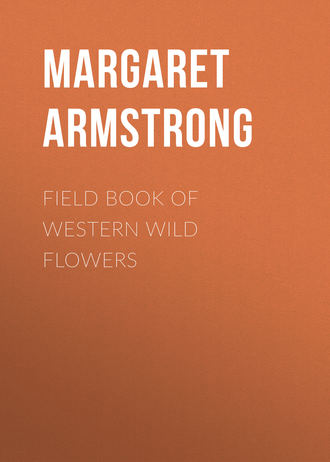 полная версия
полная версияField Book of Western Wild Flowers
Single Beauty – Moneses uniflora.
White Heather – Cassiope Mertensiana.
There are a good many kinds of Pyrola; leaves mostly from the root; flowers usually nodding, in clusters, with bracted flower-stalks; sepals and petals five; stamens ten; capsule roundish, five-lobed, cobwebby on the edges. These plants are often called Shinleaf, because English peasants used the leaves for plasters. Pyrola is from the Latin for "pear," because of the resemblance of the leaves of some kinds. The aromatic Wintergreen, or Checker-berry, used for flavoring, is a Gaultheria, of the Heath Family.
Pyrola
Pýrola bracteàta
Pink
Summer
California
One of our most attractive woodland plants, from six to twenty inches tall, with handsome, glossy, rather leathery, slightly scalloped leaves. The buds are deep reddish-pink and the flowers are half an inch across, pink or pale pink, and waxy, with deep pink stamens and a green pistil, with a conspicuous style, curving down and the tip turning up. The pretty color and odd shape of these flowers give them a character all their own and they are sweet-scented. This is found in Yosemite and in other cool, shady, moist places, and there are several similar kinds.
There are several kinds of Chimaphila, of North America and Asia, with reclining stems and erect, leafy branches.
Pipsissewa
Chimáphìla Menzièsii
White
Summer
Northwest and California
A very attractive little evergreen plant, three to six inches high, with dark green, glossy, leathery, toothed, leaves, sometimes mottled with white, and one to three, pretty flowers, about three-quarters of an inch across, with yellowish sepals and waxy-white or pinkish petals, more or less turned back. The ovary forms a green hump in the center and has a broad, flat, sticky stigma, with five scallops, and the ten anthers are pale yellow or purplish. This has a delicious fragrance, like Lily-of-the-valley, and grows in pine woods in the Sierra Nevada and Coast Ranges. Chimaphila is a Greek name, meaning "winter-loving."
INDIAN PIPE FAMILY. Monotropaceae
A small family, mostly North American; saprophytes, (plants growing on decaying vegetable matter,) without leaves; flowers perfect; calyx two- to six-parted; corolla united or not, with three to six lobes or petals, occasionally lacking; stamens six to twelve; ovary superior; fruit a capsule.
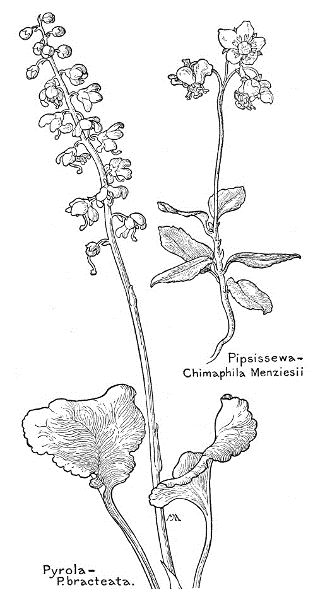
Pipsissewa – Chimaphila Menziesii.
Pyrola – P. bracteata.
Snow-plant
Sarcòdes sanguínea
Red
Spring, summer
Cal., Oreg., Nev.
The only kind, a strange plant, widely celebrated for its peculiar beauty. The name is misleading, for the splendid creatures push their way, not through the snow, but through the dark forest carpet of pine-needles, soon after the snow has melted. The fleshy stems are from six inches to over a foot tall, the leaves reduced to red scales, and the bell-shaped flowers, with five lobes, are crowded towards the upper half of the stem and mingled with long, graceful, curling, red bracts. The plants are shaded with red all over, from flesh color, to rose, carmine, and blood-red, and are translucent in texture, so that when a shaft of sunlight strikes them they glow with wonderful brilliance, almost as if lighted from within. They sometimes grow as many as fifteen together, and are found in the Sierras, up to nine thousand feet. They are pointed out to tourists by Yosemite stage drivers, but the government forbids their being picked, for fear of extermination.
Indian Pipe
Monótropa uniflòra
White
Summer
West, etc.
The only American kind, an odd plant, all translucent white, beautiful but unnatural, glimmering in the dark heart of the forest like a pallid ghost, mournfully changing to gray and black as it fades. The stem is about six inches tall, springing from a mass of fibrous roots and bearing a single flower, beautiful but scentless, about three-quarters of an inch long, with two to four sepals, five or six petals, and ten or twelve stamens, with pale yellow anthers. Sometimes the whole plant is tinged with pink. This grows in rich moist woods, almost throughout temperate and warm North America, in Japan and India, and is also called Ghost-flower and Corpse-plant.
Pine-sap
Hypópitys Hypópitys (Monotropa)
Flesh-color
Summer
West, etc.
There are two kinds of Hypopitys. This is much like the last, but not so pallid, with several stout stems, about eight inches tall, bearing a long one-sided cluster of flowers, sometimes slightly fragrant, each about half an inch long. The whole plant is waxy, flesh-color or yellowish, tinged with red or pink, and though interesting is not so delicately pretty as Indian Pipe. It seems to be a stouter plant around Mt. Rainier than in the East and grows in thick woods, across the continent and in Europe and Asia. H. sanguínea is a new kind, recently discovered in the Arizona mountains; six to twelve inches tall, growing in dense shade at high altitudes, and brilliant red throughout.
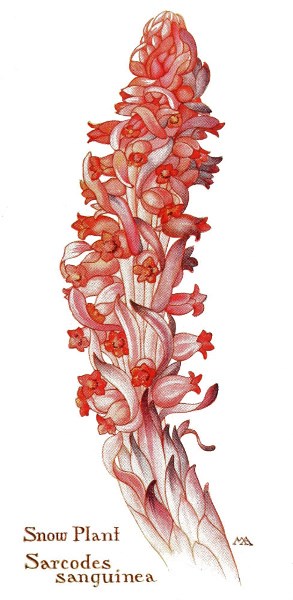
Snow Plant – Sarcodes sanguinea.
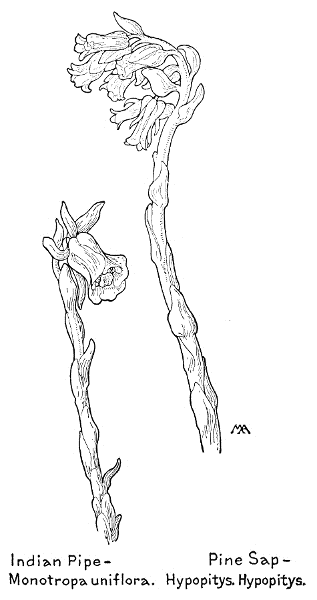
Indian Pipe – Monotropa uniflora.
Pine Sap – Hypopitys Hypopitys.
Pine-drops
Pteróspora Andromedèa
White
Summer
Across the continent
The only kind, found only in North America, a strange plant, harmonious in color, with a fleshy, brownish or reddish stem, from one to four feet tall, with yellowish bracts and covered with sticky hairs, springing from a mass of matted, fibrous, astringent roots. The flowers are a quarter of an inch long, with pink pedicels, brownish bracts, a brownish-pink calyx, with five lobes, and an ivory-white corolla, with five teeth; the stamens ten, net protruding; the style short, with a five-lobed stigma; the capsule roundish, five-lobed, with many winged seeds. We often find dead insects stuck to the stem. In winter, the dry, dark red stalks, ornamented with pretty seed-vessels, are attractive in the woods. This usually grows among pine trees, across the continent, but nowhere common. The Greek name means "wing-seeded." It is also called Giant Bird's-nest and Albany Beech-drops. Allótropa virgàta, of the Northwest, is similar, but smaller, with five, roundish sepals and no corolla.
Flowering-fungus
Pleuricóspora fimbriolàta
Flesh-color
Summer
California
There are two kinds of Pleuricospora; this is from three to eight inches tall, with flowers half an inch long, deliciously fragrant, with four or five, scale-like, fringed sepals, four or five, separate, fringed petals, resembling the sepals, and eight or ten stamens. The ovary is egg shaped, one-celled, with a thick style and flattish stigma, and the fruit is a watery berry. If the waxy, flesh-colored flowers were set off by proper green leaves they would be exceedingly pretty, but they are crowded on a fleshy stem, of the same color as themselves, mixed with fringed bracts, with brownish scales instead of leaves, and have an unnatural appearance. I found thirty of these curious plants, growing in a little company, pushing their way up through the mold and pine-needles, in the Wawona woods.
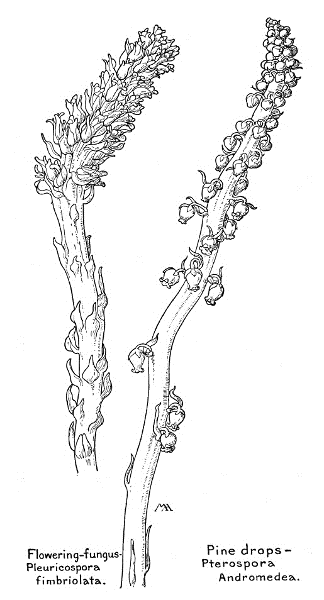
Flowering-fungus – Pleuricospora fimbriolata.
Pine drops – Pterospora Andromedea.
PRIMROSE FAMILY. Primulaceae
A rather large family, widely distributed; herbs; leaves undivided; flowers perfect, regular, parts usually in fives, corolla mostly with united petals, stamens on the base or tube of the corolla, opposite its lobes, sometimes with some extra, sterile filaments; ovary one-celled, mostly superior, with one style and round-headed stigma; fruit a capsule, with one or many seeds.
There are several kinds of Anagallis, not native in this country.
Scarlet Pimpernel
Poor-man's Weather-glass
Anagállis arvénsis
Red
Summer
West, etc.
A little weed, common in gardens and waste places, with smooth, four-sided, stems, branching and half trailing on the ground, smooth, toothless, bright green leaves and charming little flowers, a quarter of an inch or more across, with a five-lobed calyx and wheel-shaped, five-lobed corolla, usually bright orange-red and darker in the center, rarely white; the stamens five, with hairy filaments; the capsule smooth and roundish, containing many minute seeds. The flowers and leaves are usually in pairs, the seed-vessels on the tips of slender stems, curving around and toward each other, as if the plant were stretching out its little hands, and opening its little blossoms only in bright weather and closing them at night. The Greek name means "amusing." The plant was used medicinally by the ancients.
There are three kinds of Trientalis, much alike, perennials, with tuberous roots. The Latin name means "one third of a foot," the height of these plants.
Star-flower
Trientàlis latifòlia
White, pink
Spring, summer
Northwest, Cal., Nev.
A little woodland plant, with a slender stem, from three to six inches tall, bearing at the top a circle of from four to six, smooth, bright green leaves and one or two, threadlike flower-stalks, each tipped with a delicate flower. The corolla is about half an inch across, wheel-shaped, with no tube and usually with six, white or pinkish petals, sometimes deep pink, or flecked with lilac outside. The ovary makes a purplish dot in the center, surrounded by curling, yellow anthers, with threadlike filaments united at base. The capsule contains a few, rather large, white seeds. We often find these dainty little plants growing in companies, their starry blossoms glimmering in the shade, prettily set off by their neat circle of leaves.
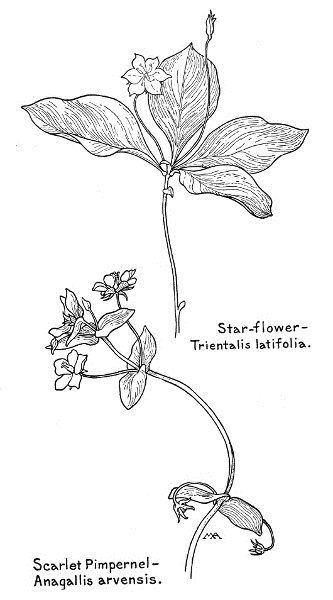
Star-flower – Trientalis latifolia.
Scarlet Pimpernel – Anagallis arvensis.
There are a good many kinds of Dodecatheon, of North America and Asia; perennials, with root-leaves; flowers in bracted, terminal clusters; calyx with four or five lobes, turned back in flower but erect in fruit; corolla with four or five, long lobes, turned strongly back over the short tube and thick throat; stamens of the same number as the lobes, the anthers pointing straight forward, inserted on the throat of the corolla, filaments short, flat and united, or lacking; style long; capsule containing many seeds. The Greek name, meaning "twelve gods," seems far-fetched, but Linnaeus fancied the cluster of flowers resembled a little assembly of divinities. Common names are Prairie Pointers, Mosquito-bills, Wild Cyclamen, and American Cowslip, the latter poor, because misleading.
Large Shooting-star
Dodecàtheon Jéffreyi
Pink
Summer
Cal., Oreg.
A very decorative plant, with a smooth, stout, reddish stem, five to eighteen inches tall, very slightly hairy towards the top, springing from a cluster of root-leaves, five to eighteen inches long, smooth, sometimes slightly toothed, and bearing a cluster of from five to fifteen beautiful flowers. The corolla is usually an inch or more long, usually with four petals, purplish-pink, paler at the base, with a yellow and maroon ring and maroon "bill." This has a faint, oddly sweet scent and grows in wet, mountain meadows. I found a very beautiful white form at Lost Lake, in Yosemite, more delicate, with lighter green foliage and pure white corollas, ringed with yellow and maroon.
Shooting-star
Dodecàtheon Clèvelandi
White
Spring
California
Not so handsome as the last, but very attractive, with a slightly roughish stem, twelve to sixteen inches tall, bearing a fine crown of flowers and springing from a cluster of smooth, slightly thickish leaves, paler on the under side, with a few teeth. The sepals are slightly downy and the corollas are about three-quarters of an inch long, with pure-white petals, sometimes lilac-tinged, yellow at base, with a ring of maroon scallops and a dark purple "bill." The flowers are deliciously fragrant, like Clove Pinks. This grows in the south.
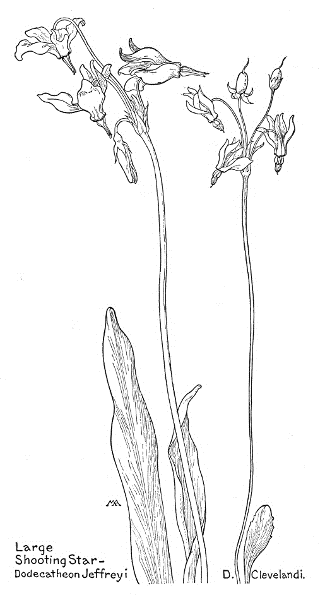
Large Shooting Star – Dodecatheon Jeffreyi.
D. Clevelandi.
Small Shooting-star
Dodecàtheon pauciflòrum
Pink
Spring, summer
West
A charming little plant, growing in wet, rich mountain meadows, with a smooth reddish stem, about eight inches tall, bearing a bracted cluster of several delicate flowers, and springing from a loose clump of smooth leaves. The flowers are about three-quarters of an inch long, with bright purplish-pink petals, with a ring of crimson, a ring of yellow and a wavy line of red, where they begin to turn back; the stamens with united filaments and long purplish-brown anthers; the pistil white.
OLIVE FAMILY. Oleaceae
A rather large family, widely distributed, including Olive, Lilac, and Privet; trees and shrubs; leaves mostly opposite; without stipules; flowers perfect or imperfect, with two to four divisions, calyx usually small or lacking, corolla with separate or united petals, sometimes lacking; stamens two or four, on the corolla, ovary superior, two-celled, with a short style or none; fruit a capsule, berry, stone-fruit, or wing-fruit.
There are many kinds of Fraxinus, almost all trees.
Flowering Ash, Fringe-bush
Fráxinus macropétala
White
Spring
Arizona
An odd and beautiful shrub, growing on Bright Angel trail, in the Grand Canyon, about as large as a lilac bush, with smooth, bright-green leaves, some of the leaflets obscurely toothed, and drooping plumes of fragrant white flowers. The calyx is very small, and the four petals are so long and narrow that the effect of the cluster is of a bunch of white fringe. The fruit is a flat winged-seed.
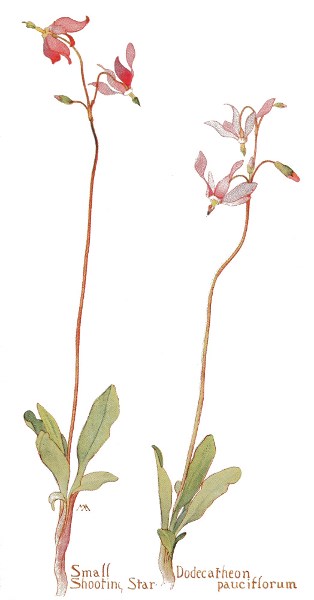
Small Shooting Star – Dodecatheon pauciflorum.
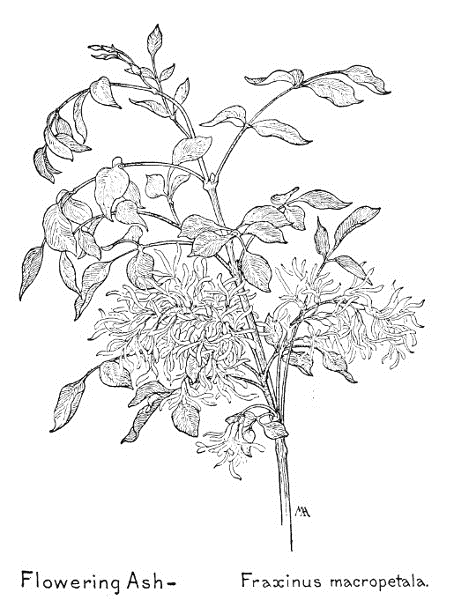
Flowering Ash – Fraxinus macropetala.
GENTIAN FAMILY. Gentianaceae
A large family, widely distributed, most abundant in temperate regions; smooth herbs, with colorless, bitter juice; leaves toothless, usually opposite, without leaf-stalks or stipules; flowers regular; calyx four to twelve-toothed; corolla with united lobes, twisted or overlapping in the bud, of the same number as the calyx-teeth; stamens inserted on the tube or throat of the corolla, as many as its lobes, alternate with them; ovary superior, mostly one-celled, with a single style or none, and one or two stigmas; fruit a capsule, mostly with two valves, containing many seeds. These plants were named for King Gentius of Illyria, said to have discovered their medicinal value.
There are several kinds of Frasera, North American, all but one western; herbs, with thick, bitter, woody roots; leaves opposite or in whorls; flowers numerous; corolla wheel-shaped, with four divisions, each with one or two fringed glands and sometimes also a fringed crown at base; stamens on the base of the corolla, with oblong, swinging anthers, the filaments often united at base; ovary egg-shaped, tapering to a slender style, with a small, more or less two-lobed, stigma; capsule leathery, egg-shaped, with flattish seeds.
Columbo, Deer's Tongue
Fràsera speciòsa
Greenish-white
Spring, summer, autumn
West, etc.
A handsome plant, though rather coarse, from two to six feet tall, with a pale glossy stem, very stout, sometimes over two inches across at the base, and very smooth, pale green leaves, in whorls of four and six, the lower ones sometimes a foot long. The flowers are mixed with the leaves all along the upper part of the stem, but mostly crowded at the top in a pyramidal cluster about six inches long, and are each nearly an inch and a half across, with a greenish or bluish-white corolla, the lobes bordered with violet and dotted with purple, and on each lobe two glands covered by a fringed flap, resembling a small petal, these fringes forming a sort of cross on the corolla. The four stamens stand stiffly out between the corolla-lobes and the general effect of the flower is so symmetrical that it suggests an architectural or ecclesiastical ornament. Though the flowers are not bright, this plant is decorative on account of its luxuriant size and pale foliage, and if Mr. Burbank could make the flowers clear white or purple it would be magnificent. It grows in the western mountains, as far east as Dakota and New Mexico. The finest I ever saw were on an open slope, in a high pass in the Wasatch Mountains, where they reared their pale spires proudly far above the surrounding herbage.

Columbo – Frasera speciosa.
Small Columbo
Fràsera nitìda
Bluish-white
Summer
Cal., Oreg.
Quite a pretty plant, too colorless to be effective at a distance, but not coarse, with a smooth, pale stem, over a foot tall, and smooth, dull, bluish-green leaves, slightly stiffish, prettily bordered with white, mostly in a clump near the base. The flowers are about half an inch across, shaped like the last; with bluish-white petals, specked with dull-purple, with a green line on the outside, with one green gland near the center, fringed all around; large whitish anthers, becoming pinkish, and a white pistil.
There are a good many kinds of Erythraea, widely distributed, usually with red or pink flowers; calyx with five or four, narrow lobes, or divisions; corolla salver-form, with five or four lobes; anthers twisting spirally after shedding their pollen; stigmas two, oblong or fan-shaped. The Greek name means "red" and the common name, Centaury, from the Latin, meaning "a hundred gold pieces," alludes to the supposedly valuable medicinal properties of these plants.
Canchalagua, California Centaury
Erythraèa venústa (Centaurium)
Pink
Spring, summer
California
From three to twelve inches tall, with apple-green leaves, mostly on the stems, smooth and thin in texture, and flowers an inch or more across, a very vivid shade of purplish-pink, with a yellow or white "eye," bright yellow anthers and green pistil. These are attractive, because they look so gay and cheerful, but the color is a little crude. The flowers are not so large in Yosemite as they are in some places, such as Point Loma, but are very numerous and cover large patches with brilliant color. These plants are called Canchalagua by Spanish-Californians, who use them medicinally.
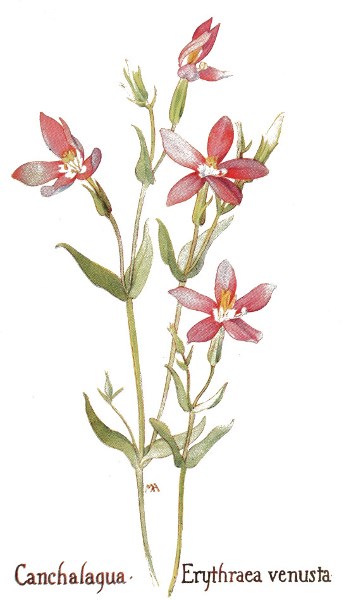
Canchalagua – Erythraea venusta.
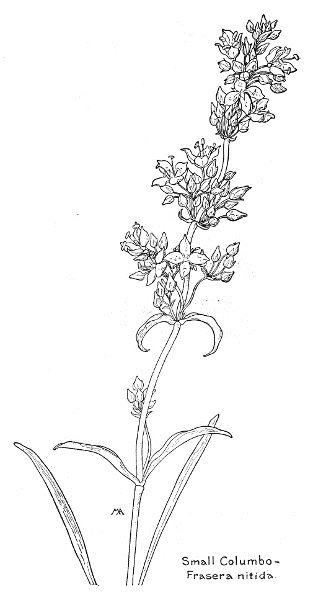
Small Columbo – Frasera nitida.
Tall Centaury
Erythraèa exaltàta (E. Douglasii) (Centaurium)
Pink
Spring, summer, autumn
West, etc.
This has a slender, leafy stem, from a few inches to over a foot tall, and flowers not so large as the last, but pretty and gay, about half an inch across, bright pink with a distinct white "eye." This grows in sandy soil, as far east as Wyoming.
There are many kinds of Gentiana, of northern regions and the Andes; calyx tubular, usually with five teeth; corolla variously shaped with from four to seven lobes, often fringed, or with folds between the teeth; style short or lacking; stigma two-lipped.
Northern Gentian
Gentiàna acùta
Purple
Summer
West, etc.
A pretty plant, with leafy, often branching stems, from six to twenty inches tall, and numerous flowers, with stiff pedicels and leafy bracts, forming several small clusters along the upper part of the stem. They are each about half an inch long, various shades of purple or blue, sometimes white, and easily recognized by the little crown of white fringe in the throat of the rather tubular, five-lobed corolla. These plants have very small roots, so that it is difficult to pick them without pulling them up, and as they are annuals they are easily exterminated. They are common in northern mountains, in moist places across the continent, and in Europe and Asia.
Gentian
Gentiàna propínqua
Purple
Summer
Northwest
This has smooth, thin leaves and pretty flowers, three-quarters of an inch long, with lilac or purple corollas, satiny in texture, with four lobes, pointed at the tips and more or less fringed. This grows in high mountains.
Blue Gentian
Gentiàna calycòsa
Blue
Autumn
Northwest
A handsome perennial, with leafy stems, from five to fifteen inches tall, bearing one or several, fine flowers at the top. They are an inch and a half long, with a bright blue corolla, dotted with green, with plaited folds and small teeth between the five lobes. This has been found in Yosemite, but is more common at Lake Tahoe. There are many other handsome large Blue Gentians in the West. G. lùtea, with yellow flowers, is the German kind from which the well-known drug, gentian, is made.
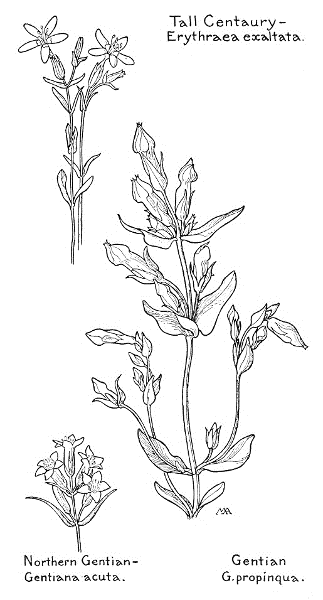
Tall Centaury – Erythraea exaltata.
Northern Gentian – Gentiana acuta.
Gentian – G. propinqua.
MILKWEED FAMILY. Asclepiadaceae
A large family, widely distributed, most abundant in warm regions; ours are perennial herbs, usually with milky juice and tough fibrous inner bark; leaves generally large, toothless, without stipules; flowers peculiar in shape, in roundish clusters; calyx with a short tube or none and five lobes; corolla five-lobed; stamens five, on the base of the corolla, with short, stout filaments, anthers more or less united around the disk-like stigma, which covers and unites the two short styles of the superior ovary. The two parts of the ovary develop into two conspicuous pods, opening at the side, containing numerous flattish seeds, arranged along a thick, central axis, usually each with a tuft of silky down to waft it about.
There are many kinds of Asclepias, with oddly-shaped flowers, interesting and decorative in form; calyx rather small, the pointed sepals turned back; corolla with its petals turned entirely back, so as to cover the sepals and expose the peculiar-looking central arrangements of the flower, called the "crown." In the middle is the large, flat, shield-shaped, five-lobed or five-angled stigma, surrounded by the anthers, which are more or less united to each other and to the stigma, encircled by five, odd, little honey-bearing hoods, the same color as the petals, each with a horn, either enclosed within it or projecting from it, the whole collection of stigma, anthers, and hoods, forming the "crown." The pods are thick and pointed. Named for Æsculapius, as some of these plants are medicinal. Indians used to make twine from the fibrous bark of some kinds.

